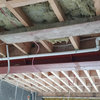Asbestos dust cleanup - need advice.
Rachel
3 years ago
last modified: 3 years ago

Sponsored
Reload the page to not see this specific ad anymore
We recently realised that a ceiling we sanded part of (1x1 metre) and which continued to crumble creating dust for around 4 years contains up to 4% chrysotile. We've had it patched up by a professional now and the visible dust underneath hoovered but I'm just really concerned about the exposure we've had and how much has been spread through the house by hoovering and walking through the dust. We also had a builder remove another ceiling with the same material around 10 years ago not knowing it contained it, there was lots of dust at the time. We're planning on removing the carpet in the room where it was crumbling, do you think keeping it damp while removing would be a good idea so any residue fibres that have settled in the carpet aren't disturbed again? Also, do you have any advice on how likely it is that asbestos is lingering in the house from the previous ceiling removal and stupidly using a hoover on the dust? My family think I'm overreacting but I just dread to think what we've been exposed to especially younger family members playing in the room when the ceiling was crumbling and us making it airborne by hoovering. Would a carpet cleaner remove anything left over? I want to chuck out the sofa in the room it was crumbling but can't persuade other family members to as they don't realised the risks and think I'm just being paranoid. I rang a company about air testing and they said as there's a low amount of asbestos in the ceiling and it was done years ago, it's very unlikely to be in the air so they don't think it's worth doing, although I don't think they realised that it continued to crumble after we sanded it. I'd appreciate any advice.

Reload the page to not see this specific ad anymore
Houzz uses cookies and similar technologies to personalise my experience, serve me relevant content, and improve Houzz products and services. By clicking ‘Accept’ I agree to this, as further described in the Houzz Cookie Policy. I can reject non-essential cookies by clicking ‘Manage Preferences’.




mii2
RachelOriginal Author